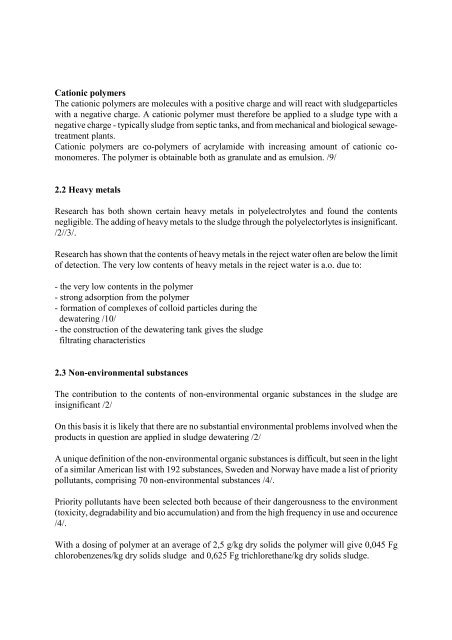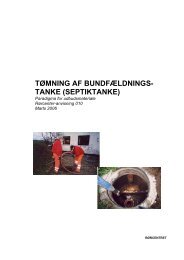The Moos KSA-system and the polymers used for ... - Simon Moos A/S
The Moos KSA-system and the polymers used for ... - Simon Moos A/S
The Moos KSA-system and the polymers used for ... - Simon Moos A/S
You also want an ePaper? Increase the reach of your titles
YUMPU automatically turns print PDFs into web optimized ePapers that Google loves.
Cationic <strong>polymers</strong><br />
<strong>The</strong> cationic <strong>polymers</strong> are molecules with a positive charge <strong>and</strong> will react with sludgeparticles<br />
with a negative charge. A cationic polymer must <strong>the</strong>re<strong>for</strong>e be applied to a sludge type with a<br />
negative charge - typically sludge from septic tanks, <strong>and</strong> from mechanical <strong>and</strong> biological sewagetreatment<br />
plants.<br />
Cationic <strong>polymers</strong> are co-<strong>polymers</strong> of acrylamide with increasing amount of cationic comonomeres.<br />
<strong>The</strong> polymer is obtainable both as granulate <strong>and</strong> as emulsion. /9/<br />
2.2 Heavy metals<br />
Research has both shown certain heavy metals in polyelectrolytes <strong>and</strong> found <strong>the</strong> contents<br />
negligible. <strong>The</strong> adding of heavy metals to <strong>the</strong> sludge through <strong>the</strong> polyelectorlytes is insignificant.<br />
/2//3/.<br />
Research has shown that <strong>the</strong> contents of heavy metals in <strong>the</strong> reject water often are below <strong>the</strong> limit<br />
of detection. <strong>The</strong> very low contents of heavy metals in <strong>the</strong> reject water is a.o. due to:<br />
- <strong>the</strong> very low contents in <strong>the</strong> polymer<br />
- strong adsorption from <strong>the</strong> polymer<br />
- <strong>for</strong>mation of complexes of colloid particles during <strong>the</strong><br />
dewatering /10/<br />
- <strong>the</strong> construction of <strong>the</strong> dewatering tank gives <strong>the</strong> sludge<br />
filtrating characteristics<br />
2.3 Non-environmental substances<br />
<strong>The</strong> contribution to <strong>the</strong> contents of non-environmental organic substances in <strong>the</strong> sludge are<br />
insignificant /2/<br />
On this basis it is likely that <strong>the</strong>re are no substantial environmental problems involved when <strong>the</strong><br />
products in question are applied in sludge dewatering /2/<br />
A unique definition of <strong>the</strong> non-environmental organic substances is difficult, but seen in <strong>the</strong> light<br />
of a similar American list with 192 substances, Sweden <strong>and</strong> Norway have made a list of priority<br />
pollutants, comprising 70 non-environmental substances /4/.<br />
Priority pollutants have been selected both because of <strong>the</strong>ir dangerousness to <strong>the</strong> environment<br />
(toxicity, degradability <strong>and</strong> bio accumulation) <strong>and</strong> from <strong>the</strong> high frequency in use <strong>and</strong> occurence<br />
/4/.<br />
With a dosing of polymer at an average of 2,5 g/kg dry solids <strong>the</strong> polymer will give 0,045 Fg<br />
chlorobenzenes/kg dry solids sludge <strong>and</strong> 0,625 Fg trichlorethane/kg dry solids sludge.




